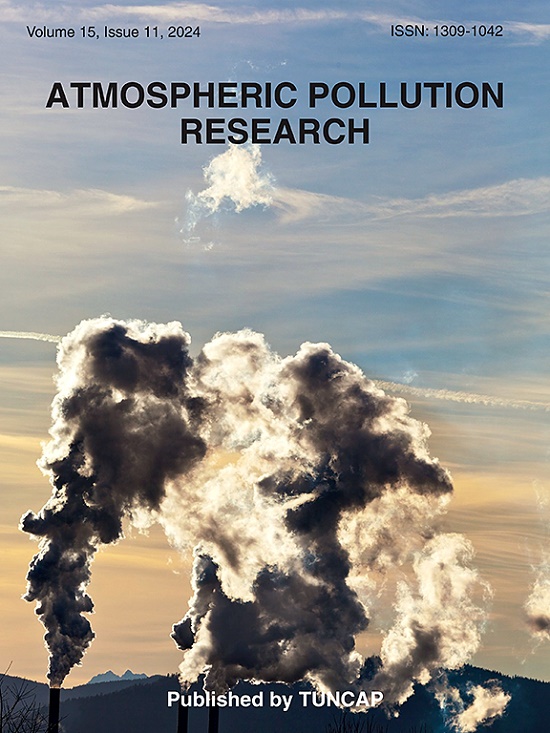Spatiotemporal estimation of surface NO2 concentrations in the Pearl River Delta region based on TROPOMI data and machine learning
IF 3.9
3区 环境科学与生态学
Q2 ENVIRONMENTAL SCIENCES
引用次数: 0
Abstract
Nitrogen dioxide () is a major air pollutant, and its concentration data are crucial for the study of air pollution and its impact on the environment. Although satellite data provide an effective method for estimating surface concentrations on a large scale through integrated modeling, the estimation of surface concentrations is hampered by the substantial amount of missing satellite data. This restricts in-depth studies of surface pollution. This study aims to reconstruct the missing data on tropospheric vertical column density from the TROPOspheric Monitoring Instrument (TROPOMI ). Subsequently, the reconstructed TROPOMI data and other predictor variables were utilized to estimate the daily surface concentrations at a 1 km resolution for the Pearl River Delta (PRD) region. The TROPOMI reconstruction models and the surface estimation model were both developed using the Extreme Gradient Boosting (XGBoost) algorithm. Additionally, comparative experiments were conducted between the XGBoost model and other traditional machine learning models, and the performances of the XGBoost model were evaluated through 10-fold cross-validation (CV) sample-based and site-based evaluations. The results indicate that the sample-based and site-based CV R values were 0.873 and 0.709, respectively. The feature importance scores indicate that TROPOMI was the most significant variable contributing to the estimation model. This indicates that the reconstruction of TROPOMI data and the development of an XGBoost model are suitable for the spatiotemporal estimation of surface concentrations in the PRD region, effectively reflecting the spatiotemporal distribution and evolution of surface concentrations in the area.
基于TROPOMI数据和机器学习的珠江三角洲表层NO2浓度时空估算
二氧化氮(NO2)是一种主要的大气污染物,其浓度数据对于研究大气污染及其对环境的影响至关重要。虽然卫星数据通过综合建模提供了一种大规模估算地表NO2浓度的有效方法,但由于卫星数据的大量缺失,对地表NO2浓度的估算受到了阻碍。这限制了对地表NO2污染的深入研究。本研究旨在重建对流层NO2监测仪(TROPOMI NO2)缺失的对流层NO2垂直柱密度数据。随后,利用重建的TROPOMI NO2数据和其他预测变量估算了珠江三角洲(PRD)地区1 km分辨率的日地表NO2浓度。利用极限梯度增强(XGBoost)算法建立了TROPOMI NO2重建模型和地表NO2估计模型。此外,将XGBoost模型与其他传统机器学习模型进行了对比实验,并通过基于样本和基于站点的10倍交叉验证(CV)评估来评估XGBoost模型的性能。结果表明,基于样本和站点的CV R2分别为0.873和0.709。特征重要性得分表明,TROPOMI NO2是对估计模型贡献最大的变量。这说明利用TROPOMI NO2数据重建和开发XGBoost模型可以有效地反映该区域表面NO2浓度的时空分布和演化,适合珠江三角洲地区表面NO2浓度的时空估算。
本文章由计算机程序翻译,如有差异,请以英文原文为准。
求助全文
约1分钟内获得全文
求助全文
来源期刊

Atmospheric Pollution Research
ENVIRONMENTAL SCIENCES-
CiteScore
8.30
自引率
6.70%
发文量
256
审稿时长
36 days
期刊介绍:
Atmospheric Pollution Research (APR) is an international journal designed for the publication of articles on air pollution. Papers should present novel experimental results, theory and modeling of air pollution on local, regional, or global scales. Areas covered are research on inorganic, organic, and persistent organic air pollutants, air quality monitoring, air quality management, atmospheric dispersion and transport, air-surface (soil, water, and vegetation) exchange of pollutants, dry and wet deposition, indoor air quality, exposure assessment, health effects, satellite measurements, natural emissions, atmospheric chemistry, greenhouse gases, and effects on climate change.
 求助内容:
求助内容: 应助结果提醒方式:
应助结果提醒方式:


